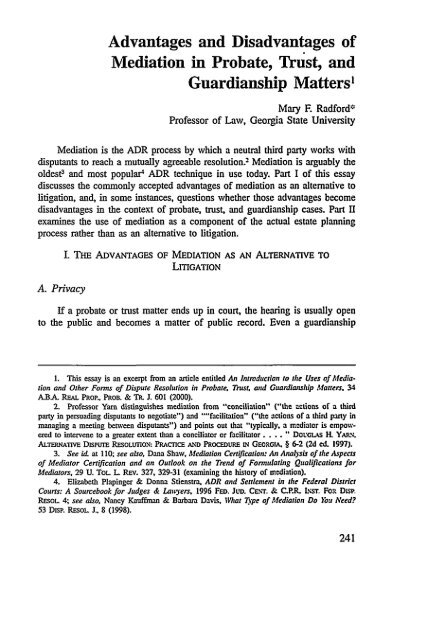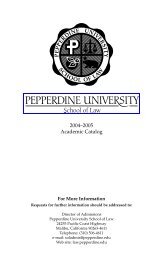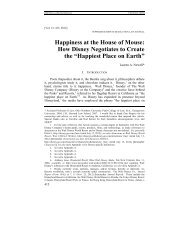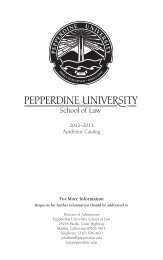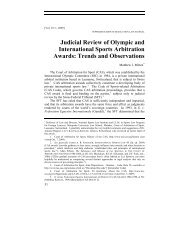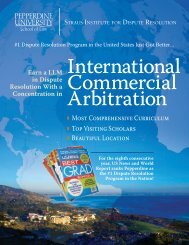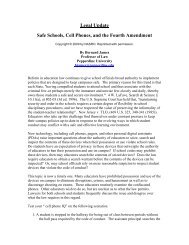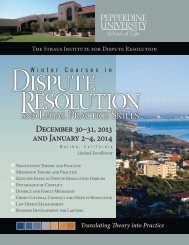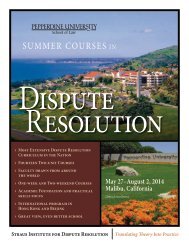Advantages and Disadvantages of Mediation in Probate, Trust, and ...
Advantages and Disadvantages of Mediation in Probate, Trust, and ...
Advantages and Disadvantages of Mediation in Probate, Trust, and ...
Create successful ePaper yourself
Turn your PDF publications into a flip-book with our unique Google optimized e-Paper software.
<strong>Advantages</strong> <strong>and</strong> <strong>Disadvantages</strong> <strong>of</strong><strong>Mediation</strong> <strong>in</strong> <strong>Probate</strong>, <strong>Trust</strong>, <strong>and</strong>Guardianship Matters lMary F. Radford*Pr<strong>of</strong>essor <strong>of</strong> Law, Georgia State University<strong>Mediation</strong> is the ADR process by which a neutral third party works withdisputants to reach a mutually agreeable resolution. <strong>Mediation</strong> is arguably theoldest 3 <strong>and</strong> most popular 4 ADR technique <strong>in</strong> use today. Part I <strong>of</strong> this essaydiscusses the commonly accepted advantages <strong>of</strong> mediation as an alternative tolitigation, <strong>and</strong>, <strong>in</strong> some <strong>in</strong>stances, questions whether those advantages becomedisadvantages <strong>in</strong> the context <strong>of</strong> probate, trust, <strong>and</strong> guardianship cases. Part 1Iexam<strong>in</strong>es the use <strong>of</strong> mediation as a component <strong>of</strong> the actual estate plann<strong>in</strong>gprocess rather than as an alternative to litigation.A. Privacy. THE ADVANTAGES OF MEDIATION AS AN ALTERNATIVE TOLITIGATIONIf a probate or trust matter ends up <strong>in</strong> court, the hear<strong>in</strong>g is usually opento the public <strong>and</strong> becomes a matter <strong>of</strong> public record. Even a guardianship1. This essay is an excerpt from an article entitled An Introduction to the Uses <strong>of</strong> <strong>Mediation</strong><strong>and</strong> Other Forms <strong>of</strong> Dispute Resolution <strong>in</strong> <strong>Probate</strong>, <strong>Trust</strong>, <strong>and</strong> Guardianship Matters. 34ABA REAL PRoP. PROB. & TR. J. 601 (2000).2. Pr<strong>of</strong>essor Yam dist<strong>in</strong>guishes mediation from "conciliation" ("the actions <strong>of</strong> a thirdparty <strong>in</strong> persuad<strong>in</strong>g disputants to negotiate") <strong>and</strong> .".facilitation" ("the actions <strong>of</strong> a third party <strong>in</strong>manag<strong>in</strong>g a meet<strong>in</strong>g between disputants") <strong>and</strong> po<strong>in</strong>ts out that "typically, a mediator is empoweredto <strong>in</strong>tervene to a greater extent than a conciliator or facilitator .... " Dot:.LAs I. YvrN.ALTERNATIVE DisPuTE RESOLUTION: PRAcnCE AND PROCEDURE N GEORGIA. § 6-2 (2d d. 1997).3. See id. at I10; see also, Dana Shaw, <strong>Mediation</strong> Certification: An Analysis <strong>of</strong> the Aspects<strong>of</strong> Mediator Certification <strong>and</strong> an Outlook on the Trend <strong>of</strong> Formulat<strong>in</strong>g Qualifications forMediators, 29 U. TOL L REv. 327, 329-31 (exam<strong>in</strong><strong>in</strong>g the history <strong>of</strong> mediation).4. Elizabeth Plap<strong>in</strong>ger & Donna Stienstra, ADR <strong>and</strong> Settlement <strong>in</strong> the Federal DistrictCourts: A Sourcebook for Judges & Lawyers, 1996 FED. JuD. CLe"r. & C.P.R. 1%sr. FOR DtsPREsOL 4; see also, Nancy Kauffman & Barbara Davis, IWat 7ype <strong>of</strong> <strong>Mediation</strong> Do You Need?53 Disp. REsOL J. 8 (1998).
hear<strong>in</strong>g, while generally not open to the public, <strong>in</strong>volves the exposure <strong>of</strong> theputatively <strong>in</strong>capacitated person <strong>and</strong> other family members to the stra<strong>in</strong> <strong>of</strong> testify<strong>in</strong>g<strong>in</strong> front <strong>of</strong> strangers about <strong>in</strong>timate matters. Privacy is an advantage <strong>of</strong>mediation that may be <strong>of</strong> particular importance <strong>in</strong> cases <strong>of</strong> this type. 5 <strong>Probate</strong>,trust, <strong>and</strong> guardianship matters <strong>of</strong>ten <strong>in</strong>volve family secrets <strong>and</strong> disputes thatare embarrass<strong>in</strong>g to the parties. The confidentiality <strong>of</strong> a mediation may encouragefamilies to speak more openly <strong>and</strong> allow the true reasons for the disputesto emerge more quickly. Privacy is particularly important to those partieswho value "not air<strong>in</strong>g the family's dirty laundry" <strong>in</strong> public. 6Additionally, parties who will cont<strong>in</strong>ue to live or operate <strong>in</strong> the same socialor bus<strong>in</strong>ess community may benefit from a "discreet conclusion" to theirproblems. 7Common law does not guarantee privacy or confidentiality <strong>in</strong> settlementdiscussions. However, it is not uncommon for state statutes to prohibit the <strong>in</strong>troduction<strong>of</strong> evidence that the parties have tried (unsuccessfully) to reach asettlement. 8 Many state statutes <strong>and</strong> ADR rules require that mediations <strong>and</strong>other ADR proceed<strong>in</strong>gs be kept confidential. 95. See generally, Susan N. Gary, <strong>Mediation</strong> <strong>and</strong> the Elderly: Us<strong>in</strong>g <strong>Mediation</strong> to Resolve<strong>Probate</strong> Disputes over Guardianship <strong>and</strong> Inheritance, 32 WAKE FoREsT L. REV. 397, 424 (1997).6. Ms. Schmitz notes that this preference is particularly prevalent among the current generation<strong>of</strong> senior citizens. Suzanne J. Schmitz, <strong>Mediation</strong> <strong>and</strong> the Elderly: What Mediators Need toKnow, MEDIATION Q., Fall 1998, at 71, 74.7. Nad<strong>in</strong>e DeLuca Elder, A <strong>Mediation</strong> Primer for the Solo or Small Firm Practitioner, 4GA. BJ.. 38 (Dec. 1998).8. See, e.g., IND. R Evo. 408.9. For example, the Indiana ADR rules provide that "ADR processes will be subject to thesame degree <strong>of</strong> confidentiality as is set out <strong>in</strong> Evidence Rule 408, supra n. 174," <strong>and</strong> stateadditionally:Mediators shall not be subject to process requir<strong>in</strong>g the disclosure <strong>of</strong> any matter discusseddur<strong>in</strong>g the mediation, but rather, such matter shall be considered confidential <strong>and</strong> privileged<strong>in</strong> nature. The confidentiality requirement may not be waived by the parties, <strong>and</strong> anobjection to the obta<strong>in</strong><strong>in</strong>g <strong>of</strong> testimony or physical evidence from mediation may be madeby any party or by the mediators.IND. R. A.D.R. 2.11. The Texas ADR Procedures Act requires that party communications dur<strong>in</strong>gADR process be kept confidential <strong>and</strong> that none <strong>of</strong> the participants (<strong>in</strong>clud<strong>in</strong>g the mediator/facilitator) may be called upon to testify <strong>in</strong> court concern<strong>in</strong>g the ADR proceed<strong>in</strong>g. TEx. Civ.PRAC. & REM. CODE ANN. § 154.073 (West 1997). Hawaii's rules provide:The mediator shall not communicate any matters discussed at the conference to any court.Likewise, parties <strong>and</strong> attorneys are pro-hibited from <strong>in</strong>form<strong>in</strong>g the court <strong>of</strong> discussions oractions taken at the mediation. This rule does not require the exclusion <strong>of</strong> any evi-denceotherwise discoverable merely because it was presented <strong>in</strong> the course <strong>of</strong> the mediation.This rule also does not require exclusion <strong>of</strong> evidence that is <strong>of</strong>fered for another purposesuch as prov<strong>in</strong>g bias or prejudice <strong>of</strong> a witness, negat<strong>in</strong>g a contention <strong>of</strong> undue delay, orprov<strong>in</strong>g an effort to obstruct a crim<strong>in</strong>al <strong>in</strong>vestigation or prosecution.HAW. R PROB. 2.1, App. A. RULE 7
[Vol. 1: 241, 2001]PEPPERDINE DISPUTE RESOLUTION LAW JOURNALSpecial problems <strong>of</strong> confidentiality may arise <strong>in</strong> a mediation if one ormore parties is represented by a guardian ad litem. In many probate or trustcases, a guardian ad litem is appo<strong>in</strong>ted to represent parties who are unborn orunknown.' 0 Additionally, guardianship statutes <strong>in</strong> many states require or encouragethe appo<strong>in</strong>tment <strong>of</strong> a guardian ad litem <strong>in</strong> place <strong>of</strong> or <strong>in</strong> addition tothe appo<strong>in</strong>tment <strong>of</strong> an attorney to represent the <strong>in</strong>terests <strong>of</strong> the proposedward." The court appo<strong>in</strong>ts the guardian ad litem, who is thus <strong>of</strong>ten obligatedto report back to the court on the progress <strong>of</strong> the case.' 2 Thus, although themediation may take place <strong>in</strong> a private sett<strong>in</strong>g (which is advantageous <strong>in</strong> <strong>and</strong><strong>of</strong> itself), the confidentiality requirement may not <strong>of</strong>fer the same protectionshere that it does <strong>in</strong> cases that do not <strong>in</strong>clude a guardian ad litem.B. Deal<strong>in</strong>g with Emotional Aspects <strong>of</strong> CasesBoth the confidentiality <strong>and</strong> <strong>in</strong>formal nature <strong>of</strong> mediation give the partiesthe opportunity to deal with the emotional issues <strong>of</strong> a case.' 3 Disputes <strong>in</strong> thecontext <strong>of</strong> probate, trust, or guardianship law may result <strong>in</strong> the tangible manifestation<strong>of</strong> long-st<strong>and</strong><strong>in</strong>g family problems (e.g., sibl<strong>in</strong>g rivalry, perceived favoritism,jealousy over or disapproval <strong>of</strong> a marriage or other relationship)."Parties <strong>in</strong> these cases may sometimes seek no more than an "emotional" resuit-an apology perhaps, or an opportunity to vent anger over a situationthey perceive as unfair.In the context <strong>of</strong> a guardianship, emotions such as fear, jealousy <strong>and</strong>greed may underlie the legal dynamic. A dispute over who should serve asguardian may reflect deeply entrenched emotional issues. For example, questionsover which child should be an elderly parent's guardian may maskdeeper suspicions as to who should have easy access to the parent, <strong>and</strong> thusan opportunity to garner his or her favor. This emotional dimension couldmake mediation <strong>in</strong> such cases much more challeng<strong>in</strong>g than <strong>in</strong> "stranger vs.stranger" cases. On the other h<strong>and</strong>, it is this dimension that requires an alternativeto a court hear<strong>in</strong>g. The judge <strong>in</strong> a guardianship hear<strong>in</strong>g is relatively10. See, e.g., GA. CODE AN. § 53-11-2 (fichie 1997). which requires the appo<strong>in</strong>tment <strong>of</strong>a guardian for parties <strong>in</strong> a probate case who are not sui jurs, are unborn, or unknown.11. See, e.g., ID'. CODE ANN. § 29-3-2-3 (Michie Supp. 1997).12. See Schmitz, supra note 6, at 78.13. See generally, Gary, supra note 5, at 426-27; see also, Brian C. Hewitt. <strong>Probate</strong> <strong>Mediation</strong>:A Means to an End, 40 Rss GEsrA., 41 (1996).14. See Gary, supra note 5, at 426-27.
limited <strong>in</strong> terms <strong>of</strong> possible result. More importantly, the courtroom is not theappropriate arena for the air<strong>in</strong>g <strong>and</strong> potential resolution <strong>of</strong> the underly<strong>in</strong>gemotional issues.'"The emotional context should be considered when plann<strong>in</strong>g the tim<strong>in</strong>g <strong>of</strong>a mediation. Typically, early mediation is recommended.' 6 However, the partiesto a will contest may still be <strong>in</strong> the process <strong>of</strong> griev<strong>in</strong>g over the loss <strong>of</strong> afamily member.' 7 Similarly, the parties <strong>in</strong> a guardianship case may still beconfront<strong>in</strong>g the shock <strong>of</strong> the visible decl<strong>in</strong>e <strong>in</strong> capacity <strong>of</strong> a loved one. Thestrong emotions surround<strong>in</strong>g a death or pend<strong>in</strong>g disability may well hamperthe parties' ability to th<strong>in</strong>k clearly, either <strong>in</strong> the context <strong>of</strong> litigation or <strong>of</strong>mediation. 8C. Preservation <strong>of</strong> RelationshipsPreservation <strong>of</strong> the family <strong>and</strong> other ongo<strong>in</strong>g relationships is another advantageto mediation.' 915. Pr<strong>of</strong>essor Gary writes that another benefit <strong>of</strong> us<strong>in</strong>g mediation <strong>in</strong> guardianship hear<strong>in</strong>gis that it "gives the older adult a voice," thus "the older adult will benefit from the chance tohear <strong>and</strong> be heard." Id. at 426. She also notes, "The litigation process itself can be traumatic.The process creates stress <strong>and</strong> anxiety for the participants-even more so when the opponent is afamily member. In litigation, even the w<strong>in</strong>ner may feel that she has lost." Id. at 428.16. See Faryl S. Moss, Mediat<strong>in</strong>g Fiduciary Disputes, app. A at A-4 (1998) (unpublishedmanuscript, on file with author). Moss describes the advantages<strong>of</strong> early mediation as follows:Disputes are usually more likely to be settled through mediation when mediation is recommendedearly. For example, when a dispute arises between a fiduciary <strong>and</strong> a beneficiary<strong>in</strong>volv<strong>in</strong>g <strong>in</strong>terpretation <strong>of</strong> the trust agreement, there is a high probability <strong>of</strong> success ifthe parties attempt to have their disagreement mediated before a lawsuit is filed. The partiesshould be able to compromise before either side becomes too <strong>in</strong>flexible <strong>in</strong> the "rightness"<strong>of</strong> their position.Id.Even though early mediation is recommended as a time <strong>and</strong> money-saver, Moss po<strong>in</strong>ts outthat it can also be quite successful when litigation has run for such a protracted period <strong>of</strong> timethat the parties have become frustrated. Also, she notes that a second mediation may be successfuleven if an earlier one was not. F<strong>in</strong>ally, a mediation, even if unsuccessful, may serve a benefitby facilitat<strong>in</strong>g the collection <strong>of</strong> <strong>in</strong>formation <strong>in</strong> a way far less costly <strong>and</strong> time-consum<strong>in</strong>g than formaldiscovery. See id. at A-5.17. Pr<strong>of</strong>essor Gary states "grief may be a factor <strong>in</strong> the dispute itself, s<strong>in</strong>ce the desire toblame someone for the death <strong>of</strong> a loved one may lead to a lawsuit." Gary, supra note 5, at 432.She cont<strong>in</strong>ues that anger is "a common by-product <strong>of</strong> grief" that may be "redirect(ed] towardfamily members <strong>and</strong> friends <strong>of</strong> the decedent." Id. at 399, n.6.18. See id. at 421. "If the mediation process is commenced too early <strong>in</strong> [the griev<strong>in</strong>g process,the parties may be ill-equipped emotionally to make rational decisions that will permit settlement<strong>of</strong> the controversy." Hewitt, supra note 13, at 41.19. See generally, Gary, supra note 5, at 428.244
[Vol. 1: 241, 2001]PEPPERDINE DISPUTE RESOLUTION LAW JOURNALMany, if not most, <strong>of</strong> the cases that arise <strong>in</strong> the probate, trust <strong>and</strong> guardianshipcontext <strong>in</strong>volve families whose lives together could be irreparably shatteredby bitter <strong>and</strong> prolonged litigation.20 In some <strong>of</strong> these cases, regardless <strong>of</strong>the outcome, it is vital that the relationship be preserved, as one family membermay rema<strong>in</strong> dependent on another for care-giv<strong>in</strong>g or f<strong>in</strong>ancial assistance.'Relationships between a trustee or other fiduciary <strong>and</strong> the beneficiariesmay also suffer unnecessarily from the adversarial context <strong>of</strong> litigation. Uponlisten<strong>in</strong>g to the beneficiaries express their needs <strong>in</strong> their own words, a fiduciarymay underst<strong>and</strong> how to deal not only with the present issue <strong>in</strong> controversy,but with issues that arise <strong>in</strong> the future as well.D. Control & Power ImbalancesIn an ADR proceed<strong>in</strong>g, particularly mediation, the parties reta<strong>in</strong> a greatdeal <strong>of</strong> control over the procedure <strong>and</strong> outcome <strong>of</strong> the case. In mediation, theparties themselves design their own resolution <strong>and</strong> thus may be more likely tobe committed to its success.? Even <strong>in</strong> arbitration or other quasi-judicial proceed<strong>in</strong>gs,parties who have chosen to enter this type <strong>of</strong> dispute resolution mayfeel less at the mercy <strong>of</strong> a legal system that they do not underst<strong>and</strong>.A disadvantage <strong>of</strong> the parties reta<strong>in</strong><strong>in</strong>g control is the potential for a morepowerful party to overpower a weaker party. This power imbalance may manifestitself <strong>in</strong> a variety <strong>of</strong> ways, thus challeng<strong>in</strong>g mediators to resist the urgeto stereotype any given situation. For example, mediators should exercise specialcare when an elderly family member is party to a dispute because theelderly person may have "some loss <strong>of</strong> capacity or is likely, due to societalcondition<strong>in</strong>g, not to assert her own <strong>in</strong>terests."23 On the other h<strong>and</strong>, while elderlypeople are <strong>of</strong>ten viewed as "<strong>in</strong>flexible, grouchy, <strong>and</strong> confused," 2 120. See Hewitt, supra note 13, at 41. Pr<strong>of</strong>essor Gary po<strong>in</strong>ts out that "family harmony" isa "tangential, but important goal" <strong>of</strong> the processes <strong>of</strong> estate plann<strong>in</strong>g <strong>and</strong> deal<strong>in</strong>g with guardianship-typeissues; she notes that "the way <strong>in</strong> which the family resolves the dispute may determ<strong>in</strong>enot only property rights, but also whether the family relationship will survive or suffer irreparabledamage." Gary, supra note 5, at 397.21. See iUL22. Ms. Schmitz states the need for control is common among senior citizens, whose recentyears have <strong>of</strong>ten been characterized as a loss <strong>of</strong> control, experienced <strong>in</strong> terms <strong>of</strong> loss <strong>of</strong>one's physical or f<strong>in</strong>ancial <strong>in</strong>dependence. See Schmitz, supra note 6. at 74, 79.23. Gary, supra note 5, at 399.24. Schmitz, supra note 6, at 73.
the ag<strong>in</strong>g matriarch <strong>of</strong> the family may actually rule (emotionally) with aniron fist <strong>and</strong> thus h<strong>in</strong>der other parties to the mediation from act<strong>in</strong>g <strong>in</strong> anymanner that would show disrespect or lack <strong>of</strong> deference.YThe potential power imbalance <strong>in</strong> a mediation may make such an approachparticularly undesirable for determ<strong>in</strong><strong>in</strong>g the appropriateness <strong>of</strong> guardianship.For example, a case <strong>in</strong>volv<strong>in</strong>g a petition for the guardianship <strong>of</strong> a parentfiled by one <strong>of</strong> the children may br<strong>in</strong>g a variety <strong>of</strong> factors <strong>in</strong>to play.Properly directed mediation could help the children reach an agreement onwhich <strong>of</strong> them is better suited to serve <strong>in</strong> a guardianship role for the parent.The forum may lead them to see that one <strong>of</strong> them is an appropriate guardian<strong>of</strong> the person, while the other should serve as guardian <strong>of</strong> the parent's property.Thus the use <strong>of</strong> mediation at an early stage may well preserve the sibl<strong>in</strong>gs'ability to work together later for their parent's benefit.On the other h<strong>and</strong>, a major issue <strong>in</strong> such a case may be whether the proposedward needs a guardian at that time. In states that require the appo<strong>in</strong>tment<strong>of</strong> an attorney for a proposed ward, 26 an <strong>in</strong>dividual's <strong>in</strong>terest <strong>in</strong> ma<strong>in</strong>ta<strong>in</strong><strong>in</strong>ghis or her <strong>in</strong>dependence would be zealously protected by an attorney<strong>in</strong> the formal guardianship proceed<strong>in</strong>g. 27 This zealous advocacy <strong>in</strong> the proposedward's favor may shatter pre-exist<strong>in</strong>g family relationships. 28 Yet, withoutthis protection, there rema<strong>in</strong>s the danger that the court may <strong>in</strong>appropriatelyimpose a guardianship. Were such a case to go to mediation, ideally themediator would seek to protect the proposed ward's <strong>in</strong>terests, as well as the<strong>in</strong>terests <strong>of</strong> the other parties. The mediator, however, would probably opposethe guardianship less vehemently than the attorney <strong>of</strong> the proposed ward. Inaddition, if the children present themselves as capable, car<strong>in</strong>g relatives whowant only the best for their parent, <strong>and</strong> the parent seems to be an angry personwith vacillat<strong>in</strong>g emotions about the guardianship, even a skilled mediatormay fall victim to help<strong>in</strong>g the family reach a result that is <strong>in</strong> the parent's best<strong>in</strong>terests, rather than a result <strong>in</strong> which he truly played an <strong>in</strong>dependent role.The same danger exists when the proposed ward is a m<strong>in</strong>or. An examplefamily manipulation <strong>of</strong> a child's future <strong>in</strong> a mediation context occurred <strong>in</strong> Inre Jason E. 29 The case began with a hear<strong>in</strong>g on whether Jason's parents'rights should be term<strong>in</strong>ated. At the request <strong>of</strong> one parent, the hear<strong>in</strong>g was25. See id. at 79.26. See, e.g., GA. CODE ANN. § 29-5-6(b)(2) (Michie 1993).27. See, e.g., In re Guardianship <strong>of</strong> Herke, No. 16852-2-II (Wash. App. Div. 3 Jan. 19,1999), <strong>in</strong> which the court-appo<strong>in</strong>ted attorney for Ms. Herke strongly opposed the guardianship,even go<strong>in</strong>g so far as to file divorce proceed<strong>in</strong>gs aga<strong>in</strong>st Ms. Herke's husb<strong>and</strong> to discourag<strong>in</strong>g himfrom pursu<strong>in</strong>g the guardianship application.28. See id.29. See generally, In re Jason E., 62 Cal. Rptr. 2d 416 (1997).
[Vol. 1: 241, 2001]PEPPERDINE DISPUTE RESOLUTION LAW JOURNALcont<strong>in</strong>ued to give the parents a chance to work through pend<strong>in</strong>g issues <strong>in</strong> amediation session. Jason's parents, foster parents <strong>and</strong> paternal gr<strong>and</strong>parents attendedthis session. The parties agreed on a long-term plan for guardianship<strong>of</strong> the child. However, the trial court did not honor the mediation agreement<strong>and</strong> <strong>in</strong>stead term<strong>in</strong>ated parental rights <strong>and</strong> approved the adoption <strong>of</strong> Jason byhis uncle <strong>and</strong> aunt. In justify<strong>in</strong>g its decision, the court noted several problemswith the agreement. Among these problems was the fact that neither the childnor his attorney had participated <strong>in</strong> the session."E. FlexibilityLitigation suffers from two major restrictions that do not apply to mediation.First, litigation assumes a result <strong>in</strong> which only one party is successful.tSecond, litigation limits the results to strict legal alternatives. <strong>Mediation</strong> allowsthe parties the opportunity to design solutions that meet their needs,while not necessarily adher<strong>in</strong>g to technical legal pr<strong>in</strong>ciples.3 The parties mayreach results that would be outside the conf<strong>in</strong>es <strong>of</strong> a typical judicial order.The flexibility <strong>of</strong> mediation also allows the parties to construct a resolutionthey perceive as "fair," perhaps prov<strong>in</strong>g more satisfy<strong>in</strong>g than a formalisticlegal resolution 3 3 Consider, for example, the flexible results that could be30. See id. at 427.31. Litigation has been described as a "power-based" process as opposed to an "<strong>in</strong>terestbased"process. Moss states:Most litigation arises <strong>in</strong> a rights-based or power-based environment. In rights-based litigation,one party, who feels their rights have been violated, tiles suit to assert their rights<strong>and</strong> v<strong>in</strong>dicate their position. This issue is adjudicated <strong>and</strong> there is a verdict that either upholdsor denies the party's position. The result is WINILOSE. . .. In mediation, conflictresolution is <strong>in</strong>terest-base In <strong>in</strong>terest-based conflict resolution, the parties attempt toreach agreement themselves with the assistance <strong>of</strong> a neutral third party, the mediator. Theparties are active participants <strong>in</strong> the process. They are there because <strong>of</strong> their will<strong>in</strong>gnessto address their dispute <strong>in</strong> that forum. They have chosen to make a good-faith effort to resolvetheir dispute themselves. Through the process <strong>of</strong> negotiation, the parties reach theagreement themselves. Because the parties have been a part <strong>of</strong> the dispute resolution, thmresults are <strong>of</strong>ten more satisfy<strong>in</strong>g. Face-sav<strong>in</strong>g can occur. Thus. a WIN/WIN result may beachieved.Moss, supra note 16, at A-i.32. See generally, Gary, supra note 5, at 430-31.33. Pr<strong>of</strong>essor Gary illustrates, for example, that many will contests are brought not becausethe contestant s<strong>in</strong>cerely believes that the testator lacked capacity or was unduly <strong>in</strong>fluenced, butbecause the distribution scheme <strong>of</strong> the will violates the contestant's basic notion <strong>of</strong> "fairness."See id. at 416-17.
achieved <strong>in</strong> the follow<strong>in</strong>g case scenario:Tom has died recently, survived by the three children <strong>of</strong> his first marriage <strong>and</strong> his secondwife. Tom had married his second wife (who is the same age as his oldest child) thirteenmonths prior to his death. Six months prior to his death, he transferred $500,000 to hiswife. There is some question as to whether this was a gift or a loan. Two weeks before hedied, while <strong>in</strong> the hospital, Tom changed his will (which had formerly divided his estateamong his children). In his new will, he bequeathed to his second wife a collection <strong>of</strong>f<strong>in</strong>e antique watches that had been collected by him <strong>and</strong> his first wife dur<strong>in</strong>g their marriage.The will directed that 2/3 <strong>of</strong> the residue <strong>of</strong> his estate be placed <strong>in</strong> a trust from whichhis second wife was entitled to the <strong>in</strong>come every year. The trustee also was given the discretionto use any <strong>of</strong> the trust property necessary for the health or ma<strong>in</strong>tenance needs <strong>of</strong>Tom's wife or children, with the rema<strong>in</strong>der to be paid to Tom's children. Tom's will directedthat the rest <strong>of</strong> his estate was to be divided equally among his three children. Each<strong>of</strong> his children has liv<strong>in</strong>g m<strong>in</strong>or children. One <strong>of</strong> Tom's gr<strong>and</strong>children has severe healthproblems.In this case, one <strong>of</strong> Tom's children has a son with chronic healthproblems for which Tom may have promised f<strong>in</strong>ancial assistance. This childexpected to receive a bequest potentially greater than that <strong>of</strong> his sibl<strong>in</strong>gs. Another<strong>of</strong> Tom's children helped amass the collection <strong>of</strong> antique watches <strong>and</strong>expected that they would be passed down to her. 4 The "legal" alternative isto declare Tom's will <strong>in</strong>valid <strong>and</strong> have the property distributed through thelaws <strong>of</strong> <strong>in</strong>testate succession. This alternative may not resolve the fairness issue,may underm<strong>in</strong>e the testator's wishes, <strong>and</strong> will probably exacerbate anyalready-exist<strong>in</strong>g family strife. <strong>Mediation</strong>, on the other h<strong>and</strong>, is not limited tothis resolution. Through mediation, the parties can divide the property toreach a more "fair" outcome. 35 For example, they could agree to a cash paymentto the second wife, a distribution <strong>of</strong> the watches to one child, <strong>and</strong> theestablishment <strong>of</strong> a trust fund to cover the medical costs <strong>of</strong> the gr<strong>and</strong>child,with the rema<strong>in</strong>der divided accord<strong>in</strong>gly among Tom's issue.34. "Significant attachment to isolated items <strong>of</strong> personal property <strong>of</strong>ten represents the genesis<strong>of</strong> probate disputes." Hewitt, supra note 13, at 43.35. Pr<strong>of</strong>essor Stulberg argues that "the mean<strong>in</strong>g <strong>of</strong> fairness is not exhausted by the concept<strong>of</strong> 'legal justice'." Joseph B. Stulberg, Fairness <strong>and</strong> <strong>Mediation</strong>, 13 Oto ST. J. ON Disp.REsOL 909, 910 (1998). He argues mediation statutes should be designed to promote outcomesthat are "fair" rather than comport with a preconceived notion <strong>of</strong> which rights or outcomesshould be secured-for example, he criticizes a family law mediation statute <strong>in</strong>tended to promote"close <strong>and</strong> cont<strong>in</strong>u<strong>in</strong>g contact with both parents after the marriage is dissolved" because it ignoresthe possibility that such an outcome may not be the most fair <strong>in</strong> every circumstance, Id. at919. Similarly, Pr<strong>of</strong>essor Gary expla<strong>in</strong>s that commonly held beliefs about how property should bedistributed (e.g., <strong>in</strong>dividuals <strong>of</strong> equal relationship to the decedent should receive equal shares)may ignore circumstantial factors, such as the sentimental value <strong>of</strong> items <strong>of</strong> property or greateremotional ties among some family members. See Gary, supra note 5, at 417.
[Vol. 1: 241, 2001]PEPPERDINE DISPUTE RESOLUTION LAW JOURNALBecause mediation is not strictly limited to relevant matters, the processmay also result <strong>in</strong> the resolution <strong>of</strong> issues that could cause unnecessary litigation<strong>in</strong> the future. For example, us<strong>in</strong>g the example above, if Tom's childrenare unsuccessful <strong>in</strong> caveat<strong>in</strong>g his will, they may later claim that his secondwife entered <strong>in</strong>to a contract with Tom that she would leave some or all <strong>of</strong>"his" property to his children <strong>in</strong> her own will. This issue can be raised <strong>and</strong>dealt with <strong>in</strong> the mediation, even though not yet ripe for litigation.F EfficiencyReduced cost is <strong>of</strong>ten cited as one <strong>of</strong> the primary advantage <strong>of</strong> mediation.36 Its <strong>in</strong>formal process allows for meet<strong>in</strong>gs to occur more quickly <strong>and</strong> fordecisions to be made, if not <strong>in</strong> the session itself, soon thereafter. This efficiencymay result <strong>in</strong> decreased legal fees. 7 Court costs (court reporter, transcript,etc.) are avoided. Mediators may charge for their services,-' but manyprograms provide for m<strong>in</strong>imal fee structures or even voluntary work bymediators.While efficiency <strong>and</strong> low cost are <strong>of</strong>ten touted as benefits <strong>of</strong> mediation,Pr<strong>of</strong>essor Stulberg po<strong>in</strong>ts out that care should be taken lest these benefits become"goals" <strong>and</strong> override the basic fairness <strong>of</strong> the process. 39 He argues thatthe pressure to be efficient may cause a mediator to restrict the parties' participation<strong>in</strong> the mediation session, favor<strong>in</strong>g legal counsel (over the partiesthemselves) due to the attorneys' tra<strong>in</strong><strong>in</strong>g <strong>in</strong> present<strong>in</strong>g issues <strong>in</strong> a concise36. See id. at 431. However, some controversy exists as to whether mediation <strong>and</strong> otherforms <strong>of</strong> ADR actually end <strong>in</strong> lower costs to the parties. See Roselle L Wissler, The Effects <strong>of</strong>M<strong>and</strong>atory <strong>Mediation</strong>: Empirical Research on the Experience <strong>of</strong> Small Claims <strong>and</strong> CommonPleas Courts, 33 WILtAmTr L REv. 565, 569-70 (1997) (cit<strong>in</strong>g studies that disagree as towhether mediation contributes substantially to the efficiency <strong>of</strong> dispute resolution). See also, DarrylVan Duch, Case Management Reform Ineffective: ADR, Other Reform-Act Fixes Don't SveTune or Money, CIRA Study Says, NAT'L L J., Feb. 3, 1997, at A6. cal. I (discuss<strong>in</strong>g conclusions<strong>of</strong> R<strong>and</strong> Institute for Civil Justice study on reforms m<strong>and</strong>ated by the Civil Justice ReformAct).37. Pr<strong>of</strong>essor Gary states "research <strong>in</strong> family law has shown that mediation costs less thanlitigation <strong>in</strong> resolv<strong>in</strong>g divorce cases." Gary, supra note 5, at 431. She cont<strong>in</strong>ues that many probatecases <strong>in</strong>volve small estates that are substantially depleted by litigation costs. See id.38. These charges may not necessarily be lower than attomeys' fees. For example, one retiredjudge <strong>in</strong> Virg<strong>in</strong>ia charges a flat rate <strong>of</strong> S350 per hour. Dawn Chase, Judge Bob Harris AveragesOne <strong>Mediation</strong> Session Every Day <strong>of</strong> the W1brk IWek, VA. LAw. WxLY., Oct. 5. 1998, at B-1.39. See Stulberg, supra note 35, at 922.
<strong>and</strong> "efficient" manner. 40 This issue merits special consideration <strong>in</strong> mediationsthat <strong>in</strong>volve people who cannot participate <strong>in</strong> extended sessions, expresstheir views clearly, or reach decisions quickly. 41Beyond this issue <strong>of</strong> flexibility <strong>in</strong> time <strong>and</strong> cost, mediation <strong>of</strong>fers basicconvenience, which may be <strong>of</strong> paramount importance for work<strong>in</strong>g parties orfor family members who are not mobile. The proceed<strong>in</strong>g is not conf<strong>in</strong>ed to aspecific courtroom at a specific date <strong>and</strong> time, but rather is subject to theneeds <strong>of</strong> the participants. 42II. THE USE OF MEDIATION IN THE ESTATE PLANNING PROCESS<strong>Mediation</strong> is typically viewed as a technique for resolv<strong>in</strong>g disputesheaded for or already embroiled <strong>in</strong> litigation. However, if a family dispute actuallyreaches litigation, irreparable harm to the family relationship may beunavoidable. 4 1 In recognition <strong>of</strong> this sad possibility, the utilization <strong>of</strong> mediationor "process consultation" 44 as a "preemptive strike aga<strong>in</strong>st potential litigation"45 has begun to take root <strong>in</strong> the community <strong>of</strong> lawyers <strong>and</strong> other estateplanners. 46 The emphasis <strong>in</strong> this type <strong>of</strong> mediation, just as <strong>in</strong> all other mediations,is to urge the <strong>in</strong>terested parties to construct their own resolutions, ratherthan settle for those imposed upon them. 4740. See id.41. While not limited to elderly persons alone, these characteristics are more likely concernswhen elderly persons are parties to the mediation or other process. See Schmitz, supra note6, at 76, 79, 80-81.42. Schmitz notes, however, that if a mediation is held <strong>in</strong> a private home, "the mediatormust gently take control <strong>of</strong> issues such as seat<strong>in</strong>g, light<strong>in</strong>g, potential disruptions, <strong>and</strong> undesiredparticipants <strong>in</strong> order to ensure privacy." Id. at 76.43. Gerald LeVan refers to family litigation as a "Doomsday Mach<strong>in</strong>e," mean<strong>in</strong>g "a destructivedevice so powerful that once activated, it can't be shut down . . . . Its destructivepower can't be recalled. Everyone loses. Nobody w<strong>in</strong>s." Gerald LeVan, Litigation - The Family'Doomsday Mach<strong>in</strong>e,' LEVAN's CORNER, February 1999, .44. The LeVan Company, which specializes <strong>in</strong> multi-discipl<strong>in</strong>ary family bus<strong>in</strong>ess consult<strong>in</strong>g,uses the term "mediator" <strong>in</strong> the context <strong>of</strong> litigation <strong>and</strong> the term "process consultants" <strong>in</strong>the family plann<strong>in</strong>g context <strong>in</strong> their correspondence. E-mail from Gerald LeVan on behalf <strong>of</strong> TheLeVan Company (Feb. 12, 1999) (on file with the author).45. John A. Gromala, The Use <strong>of</strong> <strong>Mediation</strong> <strong>in</strong> Estate Plann<strong>in</strong>g: A Preemptive Strikeaga<strong>in</strong>st Potential Litigation," CA. TR. & EST. Q., Fall 1996, at 29.46. Mr. Gromala states "<strong>Mediation</strong> <strong>in</strong> conflict resolution is a pr<strong>of</strong>ession <strong>in</strong> its adolescence.<strong>Mediation</strong> <strong>in</strong> estate plann<strong>in</strong>g is <strong>in</strong> its <strong>in</strong>fancy." Id. at 31. Mr. LeVan reports that "[tihere hasbeen much 'consciousness rais<strong>in</strong>g' among lawyers <strong>and</strong> other advisors s<strong>in</strong>ce we began consult<strong>in</strong>g<strong>in</strong> 1986. Lawyers are much more respectful <strong>of</strong> relationship issues <strong>in</strong> families, less dismissive <strong>of</strong>their importance as "touchy feely." LeVan, supra note 44.47. Mr. LeVan describes the emphasis his company places on family <strong>in</strong>volvement as follows:"It is our credo that a family that has the resources to create a valuable bus<strong>in</strong>ess or amasssignificant wealth ord<strong>in</strong>arily also has the resources to work out the family relationship issues
[Vol. 1: 241, 2001]PEPPERDINE DISPUTE RESOLUTION LAW JOURNALLawyers who represent clients <strong>in</strong> estate or bus<strong>in</strong>ess plann<strong>in</strong>g may underestimatethe importance <strong>of</strong> recogniz<strong>in</strong>g the emotional climate <strong>of</strong> such a situation.They may tend to stress transfer tax plann<strong>in</strong>g <strong>and</strong> assume "that a successfultransfer [<strong>of</strong> the bus<strong>in</strong>ess to the next generation] can be produced withquality legal tools."48 Yet, while studies show that only about one third <strong>of</strong>family bus<strong>in</strong>esses survive the <strong>in</strong>tergenerational transfer process, these samestudies attest that only 10% <strong>of</strong> these failures are "attributable to transfer taxation."s' As noted by one commentator, "personal <strong>in</strong>teractions among successorsare six times more detrimental to bus<strong>in</strong>ess successions than transfertaxation." '51An estate plann<strong>in</strong>g attorney's <strong>in</strong>ability to deal thoroughly with such issues,as <strong>in</strong> the case <strong>of</strong> <strong>in</strong>tergenerational transfer <strong>of</strong> a family bus<strong>in</strong>ess, is dueto both ethical restrictions <strong>and</strong> lack <strong>of</strong> tra<strong>in</strong><strong>in</strong>g <strong>in</strong> relevant discipl<strong>in</strong>es.5 - Ethicalissues arise because, for attorneys, plann<strong>in</strong>g for the succession <strong>of</strong> a familybus<strong>in</strong>ess "<strong>in</strong>volves m<strong>in</strong>efields <strong>of</strong> conflict<strong>in</strong>g <strong>in</strong>terests."-" Not only the parents'attorney but the children's attorneys (if they have reta<strong>in</strong>ed separatecounsel) as well may be restricted from br<strong>in</strong>g<strong>in</strong>g relevant issues to the attention<strong>of</strong> the other family members by conflict <strong>of</strong> <strong>in</strong>terest <strong>and</strong> confidentialityconcerns.Y Consequently, the parents' estate plann<strong>in</strong>g may be done "secretively,"55 whereas an open communication among the various parties couldwith regard to that valuable property. They can't avoid the "family work." nor can they designateit to their advisors. They must do that work for themselves. We help them identify the issues,organize an agenda, create the forum, hold the discussions, make the decisions, <strong>and</strong> followthrough on what they decide. \Ve are catalysts, not advisors, not experts. We respect the family'ssole jurisdiction over their issues." Jd.48. Michael D. Allen, Succession Strategies for the Family Bus<strong>in</strong>ess. A.LL-A.BA EsT.PLAN. FOR THE FrAL Bus. OWNER CoURsE OF STUD. MATERIALS (Mar. 12. 1998) at 4. Mr. Allenrefers to such plann<strong>in</strong>g as "tax driven wealth preservation plann<strong>in</strong>g." Id. at 10.49. See idL at 3.50. Id.51. Id at 4.52. See GERALD LEVAN, THE SuRvivAL Gumw FOR BusurEss FA.itnutz, ix.53. Allen, supra note 48, at 7; see also, LeVan, supra note 52, at ix.54. See Gromala, supra note 45, at 29.55. Gerald LeVan, Intergenerational Accord Eases Estate Plann<strong>in</strong>g, NAT'L U. Dec. 9,1996. Mr. Allen refers to such plans as "closet plans," which "are based on what parents th<strong>in</strong>kis right for their assets <strong>and</strong> loved ones without the benefit <strong>of</strong> c<strong>and</strong>id conversations with familymembers. Eventually, closet plans are sprung upon surviv<strong>in</strong>g family members, <strong>and</strong> the element <strong>of</strong>surprise, even if the news is good, can produce big problems." Allen, supra note 48, at 12.
serve to m<strong>in</strong>imize the threat <strong>of</strong> later litigation. 56 A neutral third party <strong>in</strong> thissituation may play the vital role <strong>of</strong> assist<strong>in</strong>g the attorneys "<strong>in</strong> collect<strong>in</strong>g allsegments <strong>of</strong> the family puzzle:" 57The mediator's role is to assist attorneys <strong>in</strong> fulfill<strong>in</strong>g their responsibility to craft a planthat will accomplish the testamentary desires <strong>of</strong> the attorneys' clients. The mediator confers,on a confidential basis, with each person separately <strong>and</strong> with the parties jo<strong>in</strong>tly. Only<strong>in</strong>formation that is authorized to be disclosed by each person will be shared withothers." 58As <strong>in</strong> other mediations, family members can agree not to ask the mediatorto testify later about matters that are discussed <strong>in</strong> confidence <strong>in</strong> the course<strong>of</strong> the mediation <strong>in</strong> a confidentiality agreement at the outset <strong>of</strong> theproceed<strong>in</strong>gs. 5 9The facilitators or mediators who work with families <strong>in</strong> the plann<strong>in</strong>gcontext <strong>of</strong>ten possess skills <strong>and</strong> expertise that most attorneys lack. 6 0 Theirtra<strong>in</strong><strong>in</strong>g as family therapists 6 or as communications experts 62 br<strong>in</strong>gs a dimensionto the plann<strong>in</strong>g process that is <strong>of</strong>ten ignored by lawyers focused primarilyon the "hard side" legal <strong>and</strong> f<strong>in</strong>ancial issues. 63 These tra<strong>in</strong>ed <strong>in</strong>dividualsact as "catalysts" to help the family develop a mutually satisfactory plan. 6456. See LeVan, supra note 52, at 2. Mr. LeVan po<strong>in</strong>ts out that "a potential heir who isgiven a chance to be heard <strong>and</strong> who has an opportunity to adjust to dispositions he or she maynot favor is much less likely to challenge the will." Id. He cont<strong>in</strong>ues, "Open <strong>in</strong>tergenerational dialoguesshould help to m<strong>in</strong>imize any suspicions <strong>of</strong> <strong>in</strong>fluence by other heirs." Id.57. Gromala, supra note 45, at 30.58. Id.59. See LeVan,, supra note 52, at 29.60. The LeVan Company <strong>of</strong>ten employs persons with expertise <strong>in</strong> "bus<strong>in</strong>ess organization,quality, mentor<strong>in</strong>g, <strong>and</strong> career assessment" along with family therapists on its family bus<strong>in</strong>essconsult<strong>in</strong>g teams. LeVan, supra note 52, at 8.61. Mr. LeVan reports that "[hiav<strong>in</strong>g a family therapist . . . is <strong>in</strong>dispensable . . .[Flamily members [rarely] object[) to hav<strong>in</strong>g a therapist on the team. . .. [They] recognize theneed for the therapists' skills <strong>and</strong> <strong>in</strong>sights. Some lawyers (mistakenly) assume that the familywill object to a therapist. Trial lawyers perceive therapists <strong>in</strong> expert witness roles rather than ascolleagues <strong>in</strong> solv<strong>in</strong>g bus<strong>in</strong>ess problems. This takes some adjustment." Id. at 8.62. See Allen, supra n. 48, at 8. He writes:Most communication problems <strong>in</strong> succession contexts boil down to abilities (or lack <strong>of</strong>abilities) <strong>of</strong> persons hav<strong>in</strong>g primary <strong>in</strong>fluence over an enterprise to engage <strong>in</strong> coord<strong>in</strong>atedactions. Family members can be taught the abilities to underst<strong>and</strong> <strong>and</strong> utilize the basicspeech acts which produce effective communication <strong>and</strong> enable coord<strong>in</strong>ated actions. Thechallenges are to f<strong>in</strong>d <strong>and</strong> reta<strong>in</strong> competent communication advisors to work with thefamilies <strong>of</strong> our clients.Id.63. LeVan, supra note 44.64. Id.
[Vol. 1: 241, 2001]PEPPERDINE DISPUTE RESOLUTION LAW JOURNALTheir role is not to supplant the estate plann<strong>in</strong>g attorey,65 but rather to workwith the attorney as part <strong>of</strong> a team focused on help<strong>in</strong>g the family structure itsown optimal plan.CONCLUSIONWhile mediation is becom<strong>in</strong>g <strong>in</strong>creas<strong>in</strong>gly popular <strong>in</strong> many areas <strong>of</strong> litigation,lawyers <strong>in</strong> probate <strong>and</strong> guardianship litigation are only beg<strong>in</strong>n<strong>in</strong>g torealize its value. The use <strong>of</strong> mediation as an alternative to litigation <strong>in</strong> thesetypes <strong>of</strong> cases <strong>of</strong>fers a host <strong>of</strong> advantages. Additionally, the <strong>in</strong>tegration <strong>of</strong>mediation <strong>in</strong>to the estate plann<strong>in</strong>g process <strong>of</strong>fers attorneys <strong>and</strong> clients alike abroader opportunity to work together with all <strong>of</strong> the <strong>in</strong>terested parties, maximiz<strong>in</strong>gthe possibility that the client's wishes will not be thwarted by unwanted,unnecessary, <strong>and</strong> expensive litigation.65. Gromala writes:A mediator recognizes the attorney's lead role <strong>and</strong> will not question the advice given byan attorney . . . . <strong>Mediation</strong> assists the attorneys. . .. <strong>Mediation</strong> builds on latent goodwill. It is the catalyst used to transform disparate messages <strong>in</strong>to a mean<strong>in</strong>gful collage, Theestate planners use their expertise to <strong>in</strong>tegrate this <strong>in</strong>formation with other data <strong>in</strong> develop<strong>in</strong>gthe plan. Gromala, supra note 45, at 29.
254


